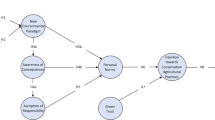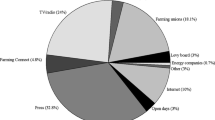Abstract
Understanding factors that motivate farmers to perform conservation behaviors is seen as key to enhancing efforts to address agri-environmental challenges. This study uses survey data collected from 277 farmers in the La Moine River watershed in western Illinois to develop new measures of farmers’ environmental attitudes and examine their influence on current usage of agricultural best management practices (BMPs). The results suggest that a Dual Interest Theory approach reflecting two separate, competing psychological frames representing a stewardship view of the environment and a farm as a business (or profit maximization) view of the environment are present within the decision making domain. Using a cluster analysis technique to examine the interaction between these attitude frames reveals four groups of farmers who hold distinct views of the environment. Further exploration of these distinct belief systems reveals little evidence of differences in participation or willingness to participate in agricultural BMPs; however, we observe significant differences between these groups with regard to their willingness to support rural conservation planning priorities that address agri-environmental challenges. Further discussion focuses on the implications of these interactive dual interest typologies and the implications of these findings on efforts to engage farmers in conservation efforts.



Similar content being viewed by others
References
Allen, J.C., and K. Bernhardt. 1995. Farming practices and adherence to an alternative-conventional agricultural paradigm. Rural Sociology 60(2): 297–309.
Arbuckle, J.G. 2012. Farmer attitudes toward proactive targeting of agricultural conservation programs. Society and Natural Resources 26(6): 625–641.
Baumgart-Getz, A., L.S. Prokopy, and K. Floress. 2012. Why farmers adopt best management practices in the United States: A meta-analysis of the adoption literature. Journal of Environmental Management 96(1): 17–25.
Beckler, J., and E. Brickner. 2006. La Moine River ecosystem partnership watershed plan. www.lamoineriver.org. Accessed May 2010.
Best, H. 2010. Environmental concern and the adoption of organic agriculture. Society and Natural Resources 23(5): 451–468.
Beus, C.E., and R.E. Dunlap. 1990. Conventional versus sustainable agriculture: The paradigmatic roots of the debate. Rural Sociology 55(44): 590–616.
Burns, R.P., and R. Burns. 2009. Business research methods and statistics using SPSS. Thousand Oaks, CA: Sage.
Chouinard, H.H., T. Paterson, P.R. Wandschneider, and A. Ohler. 2008. Will farmers trade profits for stewardship? Heterogeneous motivations for farm practice selection. Land Economics 84(1): 66–82.
Comer, S., E. Ekanem, S. Muhammad, S. Singh, and F. Tegegne. 1999. Sustainable and conventional farmers: A comparison of socio-economic characteristics, attitude, and beliefs. Journal of Sustainable Agriculture 15(1): 29–45.
Davies, B.B., and I.D. Hodge. 2006. Farmers’ preferences for new environmental policy instruments: Determining the acceptability of cross compliance for biodiversity benefits. Journal of Agricultural Economics 57(3): 393–414.
DeVellis, R.F. 2003. Scale development: Theory and applications. Thousand Oaks, CA: Sage.
Dillman, D.A., L.M. Chritian, and J.D. Smyth. 2000. Internet, mail, and mixed mode surveys: The tailored design method. Los Angeles, CA: Wiley.
Doering, O., C. Kling, J. Nassauer, and D. Scavia. 2007. Agricultural policy choices. In From the corn belt to the gulf: Societal and environmental implications of alternative agricultural futures, ed. J.I. Nassauer, M.V. Santelmann, and D. Scavia, 185–200. Washington, DC: RFF Press.
Dunlap, R.E., K.D. Van Liere, A.G. Mertig, and R.E. Jones. 2000. Measuring endorsement of the New Ecological Paradigm: A revised NEP scale. Journal of Social Issues 56(3): 425–442.
Ervin, C., and D. Ervin. 1982. Factors affecting the use of soil conservation practices: Hypotheses, evidence, and policy implications. Land Economics 58(3): 277–292.
Fishbein, M., and I. Ajzen. 2010. Predicting and changing behavior: The reasoned action approach. New York, NY: Psychology Press, Taylor and Francis Group.
Henning, S.A., Y. Zhong, and H. Cardona. 2004. Ecological attitudes of farmers and adoption of best management practices. Southwestern Economic Proceedings 31: 57–70.
IBM Corp. Released 2012. IBM SPSS Statistics for Windows, Version 21.0. Armonk, NY: IBM Corp.
Jackson-Smith, D.B., and F.H. Buttell. 2003. The social and ecological dimensions of the alterative-conventional agricultural paradigm scale. Rural Sociology 68(4): 513–530.
Jackson-Smith, D., E. de la Hoz, M. Halling, J. McEvoy, and J. Horsburgh. 2010. Measuring conservation program BMP implementation and maintenance at the watershed scale. Journal of Soil and Water Conservation 65(6): 363–373.
Lambert, D., P. Sullivan, R. Claassen, and L. Foreman. 2007. Profiles of US farm households adopting conservation-compatible practices. Land Use Policy 24(1): 72–88.
Lynne, G.D., J.S. Shonkwiler, and R.R. Leandor. 1988. Attitudes and farmer conservation behavior. American Journal of Agricultural Economics 70(1): 12–19.
Mariola, M.J. 2005. Losing ground: Farmland preservation, economic utilitarianism, and the erosion of the agrarian ideal. Agriculture and Human Values 22: 209–223.
Maybery, D., L. Crase, and C. Gullifer. 2005. Categorizing farming values as economic, conservation and lifestyle. Journal of Economic Psychology 26: 59–72.
McGuire, J., L.W. Morton, and A.D. Cast. 2013. Reconstructing the good farmer identity: Shifts in farmer identities and farm management practices to improve water quality. Agriculture and Human Values 30: 57–69.
Morris, C., and C. Potter. 1995. Recruiting the new conservationists: Farmer’s adoption of agri-environmental schemes in the U.K. Journal of Rural Studies 11(1): 51–63.
Nassauer, J.I., and R. Westmacott. 1987. Progressiveness among farmers as a factor in heterogeneity of farmed landscapes. Ecological Studies 64: 199–210.
Nowak, P. 2009. Lessons learned: Conservation, conservationists, and the 2008 flood in the US Midwest. Journal of Soil and Water Conservation 64(6): 172–174.
Nowak, P., S. Bowen, and P.E. Cabot. 2006. Disproportionality as a framework for linking social and biophysical systems. Society and Natural Resources 19(2): 153–173.
Prokopy, L.S., K. Floress, D. Klotthor-Weinkauf, and A. Baumgart-Getz. 2008. Determinants of agricultural BMP adoption: Evidence from the literature. Journal of Soil and Water Conservation 63(5): 300–311.
Prokopy, L.S., K. Genskow, J. Asher, A. Baumgart-Getz, J. Bonnell, S. Broussard, C. Curtis, K. Floress, K. McDermaid, R. Power, and D. Wood. 2009. Designing a regional system of social indicators to evaluate nonpoint source water projects. Journal of Extension 47(2).
Prokopy, L.S., Z.A. Gocmen, J. Gao, S.B. Allred, J.E. Bonnell, K. Genskow, A. Molloy, and R. Power. 2011. Incorporating social context variables into paired watershed designs to test nonpoint source program effectiveness. Journal of the American Water Resources Association 47(1): 196–202.
Reimer, A., A.W. Thompson, and L.S. Prokopy. 2012. The multi-dimensional nature of environmental attitudes among farmers in Indiana: Implications for conservation adoption. Agricultural and Human Values 29: 29–40.
Reimer, A., A.W. Thompson, L.S. Prokopy, J.G. Arbuckle, K. Genskow, D. Jackson-Smith, G. Lynne, L. McCann, L.W. Morton, and P. Nowak. 2014. People, place, behavior and context: A research agenda for expanding our understanding of what motivates farmers’ conservation behaviors. Journal of Soil and Water Conservation 69(2): 57A–61A.
Rogers, E.M. 1995. Diffusion of innovations, 4th ed. New York: The Free Press.
Schneider, M.L., and C.A. Francis. 2006. Ethics of land use in Nebraska: Farmer and consumer opinions in Washington County. Journal of Sustainable Agriculture 28(4): 81–104.
Selman, P. 1993. Landscape ecology and countryside planning: Vision, theory and practice. Journal of Rural Studies 9(1): 1–21.
Sheeder, R.J., and G.D. Lynne. 2011. Empathy-conditioned conservation: “Walking in the shoes of others” as a conservation farmer. Land Economics 87(3): 433–452.
Stuart, D., and S. Gillon. 2013. Scaling up to address new challenges to conservation on US farmland. Land Use Policy 31: 22–236.
Sulemana, I., and H. James. 2014. Farmer identity, ethical attitudes, and environmental practices. Ecological Economics 98: 49–61.
USDA (United States Department of Agriculture). 2008. 2008 Farm Bill conservation programs at a glance. http://www.nrcs.usda.gov/programs/farmbill/2008/ataglance.html. Accessed Dec 2008.
Wayman, J. 2003. Multiple imputation for missing data: What is it and how can I use it? Paper presented at Annual Meeting of the American Educational Research Association, Chicago, IL. http://coedpages.uncc.edu/cpflower/wayman_multimp_aera2003.pdf.
Author information
Authors and Affiliations
Corresponding author
Rights and permissions
About this article
Cite this article
Thompson, A.W., Reimer, A. & Prokopy, L.S. Farmers’ views of the environment: the influence of competing attitude frames on landscape conservation efforts. Agric Hum Values 32, 385–399 (2015). https://doi.org/10.1007/s10460-014-9555-x
Accepted:
Published:
Issue Date:
DOI: https://doi.org/10.1007/s10460-014-9555-x




